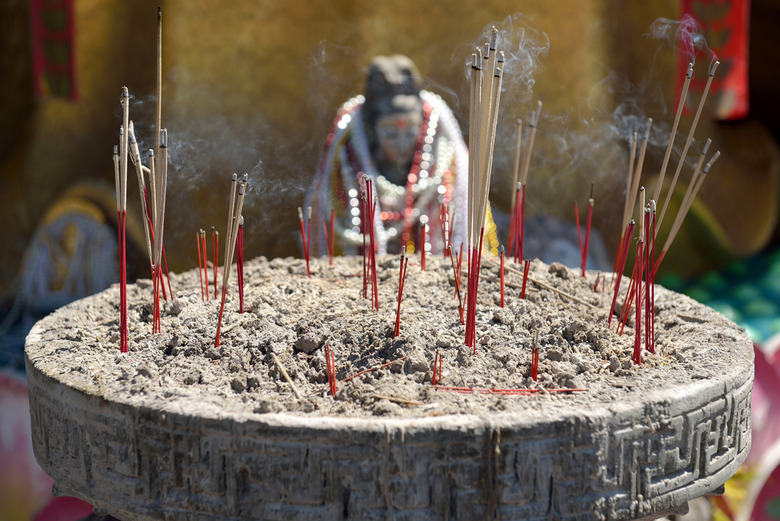10 Interesting Valentine's Day Traditions Around The World (Slideshow)
One of the strangest Valentine's Day traditions is no longer allowed in France, but that doesn't mean it shouldn't be mentioned. Known as "drawing for," unmarried men and women of all ages would enter houses facing each other and begin calling out to members of the opposite sex in an outdated courtship ritual, and if the men liked what they saw, they would "pair up." In the instance that a man was not thrilled with the lady who answered his call, he'd simply leave and go to the next house. Ladies who got "dissed" like this would then congregate at the end of the night, angry and rejected, and set a huge bonfire so they could burn effigies of the men who scorned them. Because they'd often get too riled up, this "practice" was eventually banned.
Germany
Known as "Valentinstag," V-Day in Germany is similar to that in England, France and the U.S., with cards, flowers and candies being exchanged by loved ones as the central theme; however, a couple of unique nuances to the celebration exist. The first is the pig as a symbol of luck and lust. You'll find pig-adorned items across Germany in mid-February, along with the other German Valentine's Day staple, oversized ginger cookies (often iced with rather direct messages of "love").
Mexico
In Mexico, Valentine's Day is also known as "dia del amor y la amistad," or, "day of love and friendship," so it takes on a broader tone of revelry and celebration for more than just significant others. An old tradition still exists where teenage boys and girls, in groups divided by sex, will walk past each other in a park while heading in opposite directions. If a boy likes one of the girls, he'll hand her a flower. If the girl is still holding the flower when they pass each other later, it means she likes him back. (I say just cut to the chase and ask her out!) Mexicans also enjoy covering the cars of couples with Post-It notes with expressions of love written on them.
Japan
In Japan, Valentine's Day is marked by women, and only women, presenting gifts of chocolate to their male co-workers and loved ones. Thankfully for the ladies, another holiday falls exactly one month later known as "White Day" that calls for gifts two-to-three-times as valuable to be presented to any woman who gives you chocolate on V-Day. Talk about a fast return on investment.
South Korea
Taking it one step further from Japan's women's-only gift-giving on V-Day and the sequel one month later on March 14's White Day, Koreans add another holiday to their calendar as a third (and fairly depressing) follow-up: April 14's "Black Day." Those who received no gifts on either of the first two holidays go to out to eat black noodles as a symbol of their sad single life (but, hey, at least they taste good). Another interesting fact: the 14th of every month is celebrated as a different loved-themed holiday in South Korea.
Taiwan
Here, they do the opposite of what is done in Japan and Korea: only men give gifts on Valentine's Day, and the women reciprocate on the following month's White Day. There's also 7/7 Day, which falls on the seventh day of the seventh month of the Chinese lunar calendar, which is marked by dancing and ritualistic burning of incense.
South Africa
Weeklong celebrations take place in South Africa paying homage to the ancient Roman love festival, Lupercalia, which doesn't relate directly to Valentine's Day except for falling at roughly the same time of year. Women wear the name of the man they admire on their sleeve, literally pinned there, in hopes that he'll notice and possess a similar sentiment. Much like everywhere else V-Day is observed, there's also an abundance of dining out and flower/candy exchanges.
Sweden
Translated to "All Hearts Day," Sweden's version of February 14th festivities is essentially a rip-off of the Western world's — full of candies (jelly hearts, anyone?), cards, boxes of pastries and chocolate, and, of course, floral arrangements. Keep in mind, the holiday was ignited by the flower industry in the 1960s for purely commercial interests.
Ireland
Valentine's Day is based on none other than St. Valentine, whose remains are rumored to be cloistered in Dublin, Ireland's Carmelite Church. The macabre "gift" was bestowed to the church in 1835 by Pope Gregory XVI, making the unassuming building on Whitefriar Street an interesting, albeit somewhat creepy, attraction on V-Day.
United States
Is there anything more interesting than an entire nation swept up in a love-and-consumerism-induced hysteria? The U.S. leads the world in spending on the February 14th holiday, at well over $100 per person on average. Roses are the most popular gift for adults, and children are encouraged to bring cards to school to exchange with their classmates.









